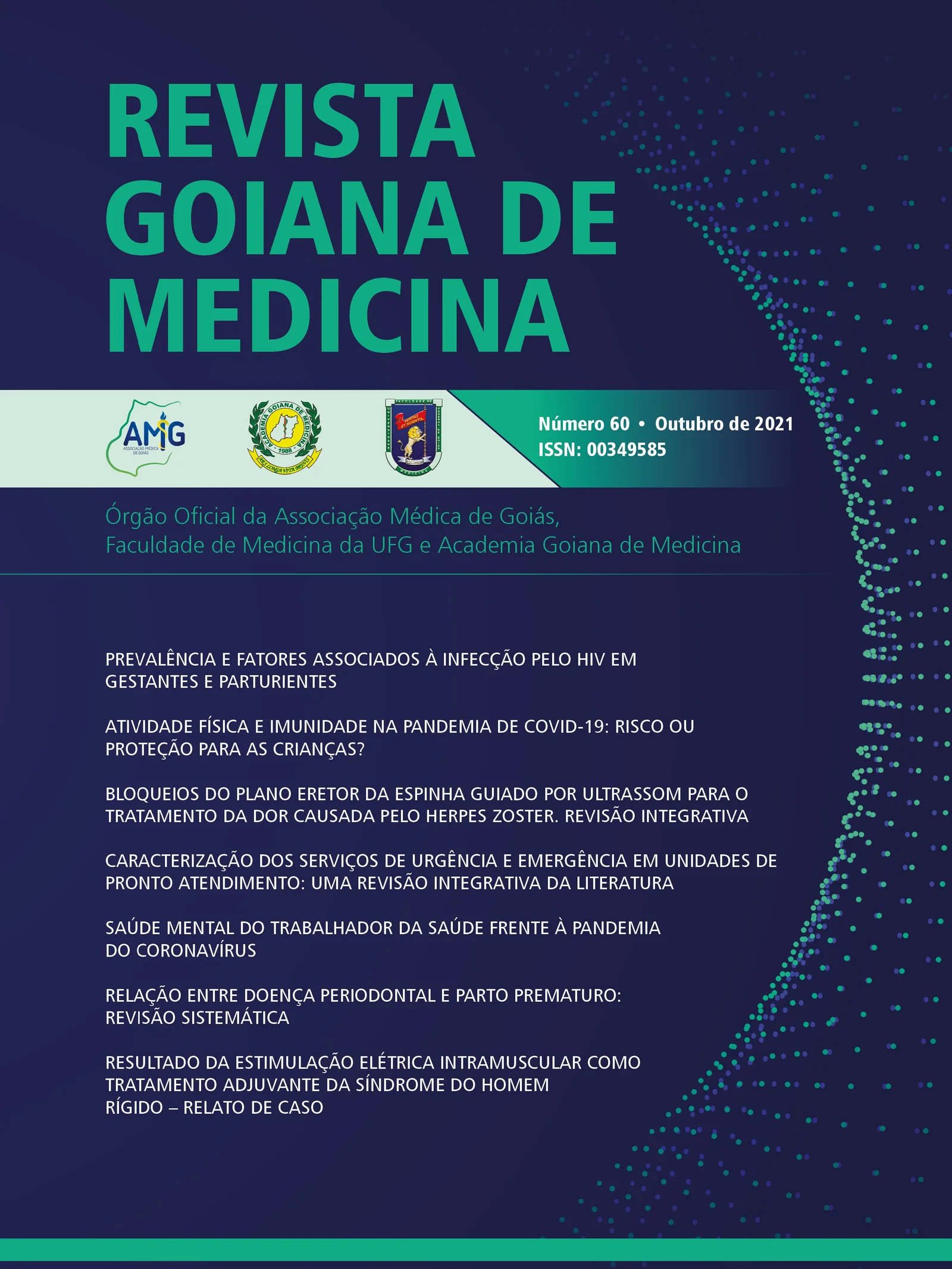Prevalence and factors associated with HIV infection in pregnants and parturients
Keywords:
HIV, GESTATION, EPIDEMIOLOGY, BRAZILAbstract
Introduction: The increase in HIV-positive heterosexuals and the consequent contamination of women in childbearing age is of great concern to public health. Thus, justifying studies to assess risk factors that lead to a greater likelihood of HIV infection by producing information for the resolution of the fight against AIDS. Objectives: To evaluate the prevalence and define factors associated with HIV infection in pregnant women and in parturients in a maternity hospital in Goiânia. Methodology: Case-control study. The case group consisted of 15 HIV-positive patients and the control of 60 non-HIV patients, a study conducted at the Dona Iris Hospital and Maternity Unit in Goiânia-Goiás, Brazil, between 08.01.2015 and 03.30.2017. Results: During the study period, 617 low-risk prenatal pregnant women were attended, 754 were at high risk and 9,451 were hospitalized in the emergency room, covering 10,822 patients. Of the 25 that presented positive serology for HIV, only 15 agreed to participate in the research. The overall prevalence of HIV-positive pregnant women attended at HMDI (prenatal and hospitalization) was 0.23%. Conclusion: The seroprevalence of HIV infection in low prenatal care was 0.32%. Seroprevalence in high risk prenatal care was 1.72%. The epidemiological profile of the participants with positive HIV serostatus is of patients with a mean age of 25 to 29 years, most of them living in a stable union, with previous number of partners > 10, schooling up to full high school, brown, evangelical and employed in the Interview, with family income between 1 and 2 minimum wages. Among the factors associated with HIV infection, two were the variables that had statistical significance when compared to the non-infected group, mean age and number of previous partners, which were higher in the group of HIV carriers.
References
Abeyá R, Sá RAM, Silva EP, Chaves Netto H, Bornia RG, Amim Júnior J. Complicações perinatais em gestantes infectadas pelo vírus da imunodeficiência humana. Revista Brasileira de Saúde Materno Infantil, 2004; 4(4), 385-390.
Brasil. Ministério da Saúde (2010a). Boletim epidemiológico AIDS/DST 2010. Versão preliminar. Brasília: Ministério da Saúde, Secretaria de Vigilância em Saúde, Programa Nacional de DST e AIDS.
Brasil. Ministério da Saúde. Boletim epidemiológico AIDS/DST 2016. Brasília: Ministério da Saúde, Secretaria de Vigilância em Saúde, Programa Nacional de DST e AIDS.
Davey DLJ, Bekker LG, Gorbach PM, Coates TJ, Myer L. Delivering preexposure prophylaxis to pregnant and breastfeeding women in SubSaharan Africa: the implementation science frontier. AIDS. 2017 Oct 23;31(16):2193-2197.
Brasil. Ministério da Saúde. Departamento de DST, Aids e Hepatites virais. Aids. 2014. Disponível em: <http://www.aids.gov.gov.br/assistencia/ etiologia_diagnostico. htm>. Acessoem: 24 out. 2014.
Chetty T, Vandormael A, Thorne C, Coutsoudis A. Incident HIV during pregnancy and early postpartum period: a population-based cohort study in a rural area in KwaZulu-Natal, South Africa. BMC Pregnancy Childbirth. 2017 Jul 26;17(1):248.
Aguilar-Zapata D, Piñeirúa-Menéndez A, Volkow-Fernández P, RodríguezZulueta P, Ramos-Alamillo U, Cabrera-López T, Martin-Onraet A. Sociodemographic differences among HIV-positive and HIV-negative recently pregnant women in Mexico City: A case-control study. Medicine (Baltimore). 2017 Jul;96(27):e7305.
Arruda SFA, Henriques AHB, Trigueiro JVS, Pontes MGA; Lima ÉAR, Torquato IMB.Desvelando o conhecimento de gestantes soropositivas acerca da transmissão vertical do HIV. Rev enferm UFPE on line, Recife, 2016,10(Supl. 3):1441-9.
Silveira MPT, Silveira MF, Müller CH. Qualidade de vida de gestantes vivendo com HIV/Aids. RevBrasGinecolObstet, 2016, 38(5): 246-52.
Silva Lr,Visgueira AF, Oliveira NL, Rocha MEMO. Variableepidemiologicalof HIV infection in pregnantwomen. RevEnferm UFPI,2016,5(1):34-9.
Vieira RBR. Perfil do conhecimento: percepção de HIV/AIDS entre gestantes. (Dissertação de Mestrado) - Universidade Católica de Santos, Programa de Mestrado em Saúde Coletiva. 2016. 69f.
Pereira GFM. Prevalência de HIV em grávidas brasileiras: pesquisa nacional. Rev Bras GinecolObstet,2016,38(8):391-8.
Barbosa RM.A Female Sterelization among WL HIV in post-HAART era: a matter of choice?In: xixInternational Aids Conference, 2014, Melbourne
Cliffe S, Townsend CL, Cortina-Borja M, Newell ML. Fertility intentions of HIV-infected women in the United Kingdom. AIDS Care. 2011 Sep;23(9):1093-101.
Paiva V, LimaTN, Santos N, Ventura-Filipe E, Segurado A. Sem Direito de Amar?: A Vontade de Ter Filhos Entre Homens (e Mulheres) Vivendo Com o HIV . Psicologia USP, 2002,13(2), 105-133.
GianvecchioRP, Goldberg TB. Fatores protetores e de risco envolvidos na transmissao vertical do HIV-1. Cadernos de Saúde Publica, 2005, 21(2):581-588.


